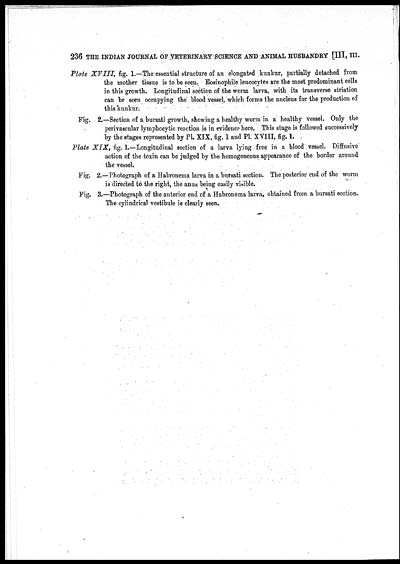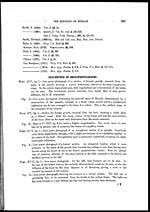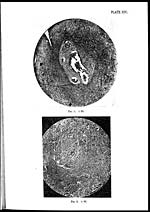Medicine - Veterinary > Veterinary colleges and laboratories > Indian journal of veterinary science and animal husbandry > Volume 3, 1933 > Original articles > Etiology of bursati
(294) Page 236
Download files
Individual page:
Thumbnail gallery: Grid view | List view

236 THE INDIAN JOURNAL OF VETERINARY SCIENCE AND ANIMAL HUSBANDRY [III, III.
Plate XVIII, fig. 1.—The essential structure of an elongated kunkur, partially detached from
the mother tissue is to be seen. Eosinophil leucocytes are the most predominant cells
in this growth. Longitudinal section of the worm larva, with its transverse striation
can be seen occupying the blood vessel, which forms the nucleus for the production of
this kunkur.
Fig. 2.—Section of a bursati growth, showing a healthy worm in a healthy vessel. Only the
perivascular lymphocytic reaction is in evidence here. This stage is followed successively
by the stages represented by PI. XIX, fig. 1 and PI. XVIII, fig. 1.
Plate XIX, fig. 1.—Longitudinal section of a larva lying free in a blood vessel. Diffusive
action of the toxin can be judged by the homogeneous appearance of the border around
the vessel.
Fig. 2.—Photograph of a Habronema larva in a bursati section. The posterior end of the worm
is directed to the right, the anus being easily visible.
Fig. 3.—Photograph of the anterior end of a Habronema larva, obtained from a bursati section.
The cylindrical vestibule is clearly seen.
Set display mode to: Large image | Zoom image | Transcription
Images and transcriptions on this page, including medium image downloads, may be used under the Creative Commons Attribution 4.0 International Licence unless otherwise stated. ![]()
| Permanent URL | https://digital.nls.uk/75230356 |
|---|
| Description | Covers articles from 1933. |
|---|




